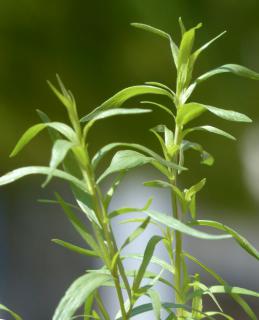

Tarragon is a delicious herb plant perfectly suited to our climates.
Name – Artemisia dracunculus
Family – Asteraceae
Type – semi-evergreen perennial
Height – 16 inches to 5 feet (40 to 150 cm)
Exposure – full sun
Soil – rich and light
Harvest – May to October
Caring for it from planting to harvest is easy and it will quickly come flavor most of your meals, sauces and mixed salads.
Tarragon likes it when the sun shines on it a lot, and fares best in light and well drained soil.
If you purchase your tarragon in pots, plan to re-pot it quickly in a larger pot or transplant it directly in the ground after buying.
You can either sow in a sheltered place at the end of winter or beginning of spring, or you can sow directly in the ground throughout the month of May.
Russian tarragon is perhaps the only variety that can actually be sown in place all spring and summer long.
As soon as the plants have formed 4 or 5 leaves, thin to about 8 inches (20 cm) to give the seedlings space to grow.
It is very easy to multiply tarragon by collecting basal shoot, preparing cuttings or layering.
Leaves can be cut as needs arise until the first frost spells.
It is best to snip the stems off one at a time whenever you need some, instead of tearing out a whole bunch.
In fall, in order to keep your tarragon for the longest possible span of time, cut it short and freeze it in a jar, keeping the stems with leaves whole.
To keep tarragon for an even longer period, it’s also possible to dry the leaves in a dry place where the air circulates well.
Alternatively, instead of powderizing them, you can simply dry the stems whole, snip them up somewhat, and store in an airtight jar.

People love using it to flavor seasoning for mixed salads and omelettes, but it is simply amazing when paired with poultry, for example the famed recipe for tarragon chicken.
It is an essential ingredient in the renowned Béarnaise sauce.
Note also that tarragon is associated to many, many health benefits and medicinal properties. For instance, it is an antioxidant that helps counter ageing.
To regenerate your tarragon, perform crown division in spring every three years, if you can.
Credits for images shared to Nature & Garden (all edits by Gaspard Lorthiois):
Sprigs of tarragon by Nathan Elliot ★ under Pixabay license
Tarragon tips by Hans Braxmeier under Pixabay license